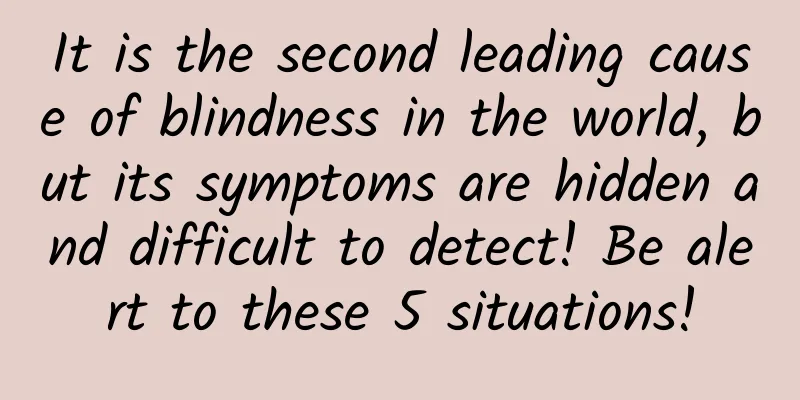It is the second leading cause of blindness in the world, but its symptoms are hidden and difficult to detect! Be alert to these 5 situations!

|
March 6 is World Glaucoma Day . When the eyes feel uncomfortable, most people will choose to "endure it and it will pass", but the symptoms we usually ignore may actually be signs of glaucoma. Glaucoma is the second leading cause of blindness in the world, but its symptoms are hidden and difficult to detect, so it is called the "invisible killer." So, when should we be careful of glaucoma when we have what symptoms? How can we prevent glaucoma? How can we distinguish between various rumors about glaucoma? This article provides a comprehensive explanation. Image source: Copyright Library What is glaucoma and what are the dangers? Glaucoma is a group of diseases with characteristic optic atrophy and visual field loss as common features. Pathological increase in intraocular pressure is its main risk factor. When the intraocular pressure rises to a level that exceeds the tolerance of the optic nerve, characteristic optic atrophy and visual field loss will occur. The maintenance of normal intraocular pressure depends on the dynamic balance of the production and outflow of aqueous humor in the eye. An important site for the outflow of aqueous humor from the eye is the angle of the chamber, which is normally open. For primary glaucoma, clinically it is generally divided into open-angle glaucoma or angle-closure glaucoma according to whether the anterior chamber angle is open or closed when intraocular pressure rises. The two types of glaucoma have different pathogenesis, completely different clinical manifestations, and different degrees of disease progression, but both can cause irreversible optic nerve damage and visual field loss in the late stages, and in severe cases can lead to blindness. The harm of glaucoma has always been taken seriously by people, but many people do not understand or have certain misunderstandings about some of the symptoms and causes of glaucoma, and it is difficult to distinguish the truth from the false rumors about glaucoma on the Internet, which greatly affects patients' judgment and treatment of glaucoma. Next, let's learn about the symptoms, causes and common misunderstandings about glaucoma. Image source: Copyright Library Causes and classification of glaucoma: 1. Whether it is open-angle or closed-angle glaucoma, there is a certain genetic tendency. If there is a family history of glaucoma, 10-15% of the direct relatives may suffer from the disease, and the risk of disease is significantly higher than that of the general population. 2. Patients with primary angle-closure glaucoma often have characteristic anatomical factors: shallow anterior chamber, narrow angle, small cornea, large lens, short axial length - narrow anterior segment of the eye and crowded structure. These factors often cause patients to be hyperopic. Therefore, people with hyperopia are at high risk of developing angle-closure glaucoma. People with such characteristic anatomical factors will experience acute closure of the angle of the chamber under certain physical or external triggering factors (emotional fluctuations, excessive fatigue, excessive close-range eye use, dark room environment, sudden climate change, etc.), and the outflow of aqueous humor will be blocked. A large amount of accumulation in the eye will cause a sharp increase in intraocular pressure, and the intraocular tissue, especially the optic nerve, will be affected in a short period of time. This is called primary acute angle-closure glaucoma. In some patients, the angle of the chamber will gradually close, resulting in a slow and progressive increase in intraocular pressure and damage to the optic nerve. This is called primary chronic angle-closure glaucoma. 3. High-risk groups for primary open-angle glaucoma include patients with myopia, diabetes, retinal vein occlusion, and hypotension. The angle of the chamber of these patients is always open, but the intraocular pressure will progressively increase. The onset of the disease is very hidden and cannot be detected in the early stages. However, the optic nerve will undergo characteristic optic disc depression and damage under the action of high intraocular pressure, leading to visual field defects. There is also a special group of people among patients with primary open-angle glaucoma. These patients will also have progressive damage to their optic nerves and their angles are also open, but the intraocular pressure is within the normal range throughout the entire disease process. This is called normal-tension glaucoma. Beware of glaucoma if you have these symptoms: 1. One-sided eye swelling accompanied by headache, blurred vision, and even high blood pressure, nausea and vomiting 2. Seven-color circles or halos appear around lights with one eye 3. It is easy to fall or bump into something when walking, and it is easy to fall down the stairs 4. Limited movement at night or in dark places 5. Driving safety is reduced and the vehicle is prone to scratches Image source: Copyright Library 01 Myth: People with good eyesight will not suffer from glaucoma The truth: Glaucoma damages the optic nerve, and the first change it causes is the visual field. The visual field is the range of space we can perceive, also known as peripheral vision. The vision we usually refer to is called central vision. Therefore, glaucoma mainly affects peripheral vision in the early stages, causing the range to become narrower and narrower, but the central vision is not damaged, so patients often do not notice it in the early stages. Even when the visual field is severely damaged, the central vision may still remain normal, but the range of space that the patient can perceive has become very narrow. Therefore, glaucoma cannot be evaluated by the quality of vision. 02 Myth: Hyperopia is less likely to develop glaucoma The truth: Patients with primary angle-closure glaucoma often have characteristic anatomical factors that basically match the anatomical characteristics of hyperopia, so people with hyperopia are at high risk of acute angle-closure glaucoma. 03 Myth: Glaucoma is an old age disease, young people don’t get it The truth: The elderly are indeed a high-risk group for glaucoma, but this does not mean that young people will not get glaucoma. Especially for open-angle glaucoma, the onset age is relatively early, and there are often early symptoms of the disease at a young age, but because the symptoms are not obvious and the disease progresses slowly, it is often ignored by patients. It is not until the middle and late stages of the disease that obvious visual field defects appear, leading to life difficulties, that they are discovered by medical treatment. In addition, glaucoma can also be congenital and adolescent, which are often related to genetic factors. 04 Myth: High intraocular pressure means glaucoma The truth: Glaucoma cannot be judged simply by the level of intraocular pressure. Glaucoma patients are often accompanied by high intraocular pressure, but not all glaucoma patients have high intraocular pressure. There is also a special group of people among primary open-angle glaucoma patients whose intraocular pressure is within the normal range throughout the course of the disease, which is called normal-tension glaucoma. In addition, high intraocular pressure does not mean that glaucoma has occurred. Many people have high intraocular pressure, but long-term follow-up has not shown damage to the optic nerve and visual field. We call this ocular hypertension. The normal value of intraocular pressure is not an absolute concept, but a statistical normal range. The tolerance of intraocular pressure and optic nerve is a balance. Only when the intraocular pressure exceeds the tolerance of the optic nerve can it cause optic nerve damage. If the tolerance of the optic nerve is high, glaucoma will not occur even if the intraocular pressure exceeds the normal range; on the contrary, if the tolerance of the optic nerve is poor, glaucoma will occur even if the intraocular pressure is within the normal range. 05 Rumor: Exercise will increase intraocular pressure, so people with glaucoma should not exercise The truth: Studies have shown that aerobic exercise can regulate and reduce intraocular pressure. Therefore, appropriate aerobic exercise, such as jogging and swimming, is beneficial to glaucoma patients. Image source: Copyright Library 06 Rumor: Playing with your phone with the lights off can also cause glaucoma The truth: When playing with a mobile phone in the dark, the pupil will dilate to ensure that enough light enters the eye. For patients with shallow anterior chamber, narrow angle, small cornea, large lens, and short axial length, the risk of angle closure will be further increased, leading to an acute attack of primary angle-closure glaucoma. Playing with a mobile phone with the lights off is a bad habit in itself. Even for people who do not have the anatomical factors of angle-closure glaucoma, there will be adverse consequences such as visual fatigue, dry eyes, and sleep disturbance. 07 Myth: Glaucoma can be cured just like cataracts The truth: For angle-closure glaucoma, the cause of the disease is relatively clear. If the angle closure can be relieved and the possibility of angle stenosis can be eliminated through surgery in the preclinical or early stage of the disease, the function of the angle still exists, so it can be cured. For primary open-angle glaucoma, the lesions are not completely clear. Currently, intraocular pressure can only be controlled through long-term medication or surgery to minimize optic nerve damage. However, if the angle damage is severe, no matter what type of glaucoma, even with surgery, it may only partially solve the problem of controlling intraocular pressure, and long-term medication is required to control intraocular pressure after surgery. Therefore, for the vast majority of glaucoma patients, glaucoma is a lifelong disease that requires lifelong medication to control intraocular pressure and optic nerve damage. 08 Myth: Glaucoma does not cause blindness The truth: Glaucoma's damage to the optic nerve is irreversible. Even if the disease is controlled through surgery or drugs, it can only protect the intact optic nerve fibers, but cannot restore the necrotic nerve fibers. If it is not discovered in time, or the drug and surgery are not well controlled, the optic nerve damage caused by glaucoma will progressively worsen, the visual field will gradually narrow, and eventually lead to blindness. Image source: Copyright Library Glaucoma is a "thief" of vision. To prevent glaucoma, you should do the following: 1. Regular eye examinations are most important, including visual acuity, intraocular pressure, fundus and chamber angle. 2. Avoid reading in the dark for a long time with your head down. 3. If you experience blurred vision or halo vision in one eye, accompanied by pain at the base of the nose or headache, you need to go to the hospital for treatment in time, even if the symptoms can be relieved on their own. 4. It is easy to fall or bump into things while walking, and movement is limited at night or in dark places, so you need to see an ophthalmologist promptly. 5. If glaucoma is diagnosed, especially open-angle glaucoma, lifelong medication is often required to avoid chronic damage to the optic nerve. 6. Appropriate aerobic exercise is beneficial for patients diagnosed with glaucoma. Author: Zhou Qiang, Chief Physician of Ophthalmology, Beijing Chaoyang Hospital, Capital Medical University Review | Tao Yong, Chief Physician of Ophthalmology, Beijing Chaoyang Hospital, Capital Medical University The article is produced by "Science Refutes Facts" (ID: Science_Facts). Please indicate the source when reprinting. The pictures in this article are from the copyright gallery and are not authorized for reproduction. |
Recommend
How many steps are needed to keep a spacecraft “neither hot nor cold” in the universe?
When we imagine space You might think of the vast...
How did a free reading app gain tens of millions of users in just half a year?
Free reading apps have gained tens of millions of...
I have summarized 8 ways to attract traffic from Douyin
When the graphic and text fields and other fields...
Teach you how to click the "+" sign in the upper right corner of WeChat. In addition to scanning codes to identify objects, there is also a hidden scanner
The question I want to discuss with you today is:...
7 major trends in mobile app marketing and promotion in 2019!
In today's mature application market, consume...
Himalaya traffic-generating skills, once you master them, you won’t have to worry about adding followers!
In the eyes of many newbies, generating traffic i...
Learn how to place Zhihu information flow ads in one article!
Today I decided to use this article to talk about...
Rules for Creating Popular Online Course Products
In July this year, the "double reduction&quo...
Changsha tea tasting is worth recommending. Bring your own studio to drink tea. High-end takeaway is reliable and shared with everyone.
Changsha Tea Tasting recommends bringing your own...
As the iPhone’s “remaining power” is about to fade, how can the smartphone industry survive the “ten-year itch”?
It turns out that not only our country’s economy ...
Civil Service Exam Sprint: 17 lessons to get high scores in essay writing, break through difficulties, and pass the exam easily
Course Description: 1. Comprehensive. The course ...
Some thoughts on Android APP performance optimization
When it comes to Android phones, most people have...
The marketing hotspot for the whole year of 2018, a must-have for operators and promoters! !
In the blink of an eye, it is the end of 2017 aga...
How to write Double Eleven copy to encourage users to place orders?
When it comes to copywriting , the first thing pe...









